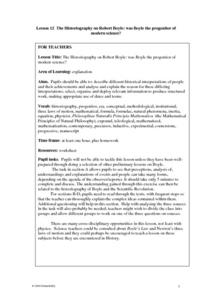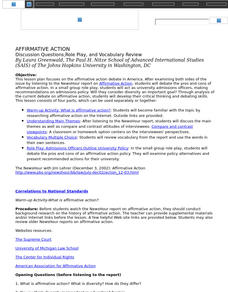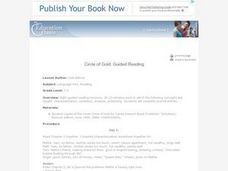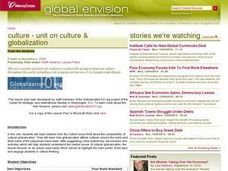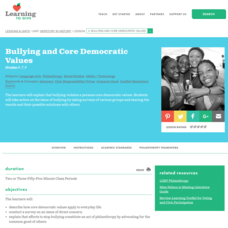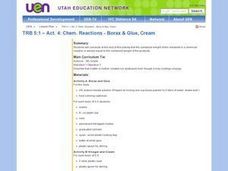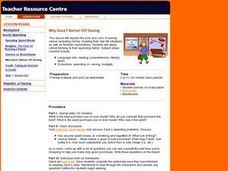Curated OER
The Historiography on Robert Boyle: Was Boyle the Progenitor of Modern Science?
Students participate in a warm-up activity by attending a football match writing an account of who won the game. They discuss how their account could differ from someone else's account of the game. They discuss how different people's...
Curated OER
ANDERSONVILLE PRISON: AN ECONOMIC MICROCOSM
Students identify the conditions faced by the prisoners of war at Andersonville during the Civil War. They examine how a group of civil war prisoners developed an economic system within their camp.
Curated OER
AFFIRMATIVE ACTION
Students debate the pros and cons of affirmative action. In a small group role play, students act as university admissions officers, making recommendations on admissions policy.
Curated OER
Circle of Gold: Guided Reading
Students participate in 8 guided reading sessions in which they read the novel, Circle of Gold, by Candy Dawson Boyd. They focus on and discuss characterization, synthesis, analysis, and predicting. They complete journal entries and...
Curated OER
Culture - Unit on Culture & Globalization
Students examine the spread of American culture throughout the world. They read an article, discuss items made by foreign-owned companies, complete handouts, read and discuss a case study, and conduct a role-play about a U.S.-Canada...
Curated OER
World Summit on Climate Change
Students work in small groups researching the impact of climate change on a particular country, and predict future impacts for this country. They simulate an international summit on climate change. Students understand the impact of the...
Curated OER
Where in the World?
Students locate famous landmarks around the world. They identify the location of natural and manmade landmarks using a worksheet that provides ten clues.
Curated OER
Architecture Scavenger Hunt
Ninth graders explain basic terms and identify illustrations of architectural features and styles. They locate and identify the different architectural styles and terminology that exists in the community and neighborhoods that they live...
Curated OER
Organ Systems
Students state the name of major body systems, They identify what each system does and list the major organs in each system. In addition, they complete a puzzle matching organ systems to organ function.
Curated OER
Area and Perimeter of Regular Polygons - An Extension
Pupils explore the relationship between area and perimeter of polygons.They measure the area and perimeter of regular polygons inscribed in a circle. Learners then discuss how as the number of sides of a regular polygon increase, the...
Curated OER
Bullying and Core Democratic Values
Middle schoolers explore the concept of core democratic values. After completing a survey of student populations regarding bullying, small groups analyze their findings and present their findings to the Student Council, principal,...
Curated OER
Fantasy Basketball
Learners play Fantasy Basketball in order to practice locating Internet information and using technology tools to display data; students demonstrate an understanding and use of graphing, probability, and statistics.
Curated OER
MAKING CONNECTIONS WITH MAPS
Students define choropleth map. They construct a choropleth map. They interpret a choropleth map. They present geographic information.
Curated OER
Chemical Reactions - Borax & Glue, Cream
Fifth graders, in groups, complete two activities in which various substances are combined, resulting in a very different substances. They discuss reactants and products and chemical reactions.
Curated OER
Why Save? Better Off Saving
Students examine the pros and cons of saving versus spending money and evaluate real-life situations as well as their own spending habits. They discuss the best and worst purchase they have made and why, explore the "Downtown...
Curated OER
Percentages in Word Problems
Eighth graders, after brainstorming all the places they see percentages in every day life (sales, basketball, grades, etc.), calculate percentages from bases and parts in word problems. They review their notes together on percentage...
Curated OER
Reading Chemical Formulas
Students interpret basic chemical formulas. When class begins, students interpret a "chemical formula" for fruit salad. After they interpret the recipe, students use the same strategies to identify chemical formulas. They evaluate the...
Curated OER
Real Math
Students explore careers that require math knowledge and solve real life math problems. As a class, they compare and contrast classroom math to real life math and explore the links between algebra, geometry and math skills used in...
Curated OER
Holes
Students distinguish between primary and secondary sources when researching on the Internet and evaluating historical records. They recognize important features of a primary source such as the type of document, who created it, what is...
Curated OER
Weekly Math Challenge
Young scholars solve a new math challenge every week. In this math center activity, students explain the process of solving the weekly challenge. Young scholars are assessed on what is included in their challenge notebook. Students earn...
Curated OER
Adopt a Geographic News Story
Learners explore geography and the environment by reading the news. They discuss why it is important to follow the news. Students adopt a geographic news story, research the topic, and design posters to illustrate the story.
Curated OER
Here's an Instant Activity for September 6, 2004
What are the words that use the silent e? With this resource, youngsters complete a teacher-led activity for spelling words with silent e sounds. They then complete a worksheet that adds suffixes s, ed, or ing to words that end in silent e.
Curated OER
On a Hunt for Simple Machines
Fifth graders identify six simple machines. They brainstorm types of machines and complete a KWL chart. Students observe and explain six simple machines found in the classroom and in their home. They share their list with the class.
Curated OER
What's Hiding in Your Home Cabinets?
Young scholars analyze a variety of products found in their own homes to determine their toxic content. They identify words such as caution, warning or danger and relate them to their relative toxicity levels.
